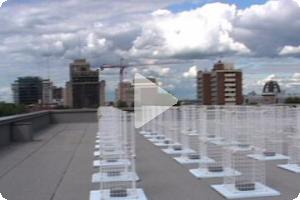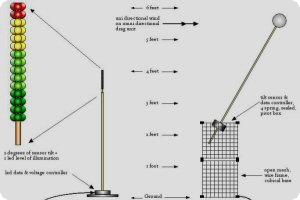Please wait a few moments while we process your request

Steve Heimbecker
Wind Array Cascade Machine - Si(g)n(e)
Wind Array Cascade Machine (WACM) is a device that captures the wind’s direction and movement and then streams the resulting data on the Web and uses them for installation projects. Thanks to the 64 motion sensors forming a grid of 8 units by 8 units, the system "maps" the wind in an outdoor space. Streamed on the Web, the data from the 64 channels are then processed by a computer program and assigned to installations that translate them into another form.(1)
The system has already spawned an installation, Pod, presented at the Mois Multi 2003 in Quebec City, as well as at the Subtle Technologies conference (2003) at the Interaccess centre in Toronto. During these two presentations, the sensing device was placed on the roof of the Méduse complex in Quebec City, and the data transmitted by the network were used to control a series of corresponding light emitting diodes (LEDs) placed on long vertical rods in an exhibition space. Installed for a full year (2004-2005) on the roof of the Ex-Centris complex in Montreal, WACM powered the August 2004 Pod presentation at the Kiasma Museum of Contemporary Art in Helsinki, Finland, as part of ISEA 2004, as well as its presentation at Oboro in Montreal in November and December of the same year. The resulting luminous installation evoked a windswept field of wheat, thereby creating a visual analogy to express a natural phenomenon that is hard to perceive.
This system is similar to other devices created by artists integrating natural elements (for example, the wind and sun) into kinetic art. Yet Pod differs from this work in that the wind isn’t used for its energy potential but rather because it describes a space by occupying and modifying it. Such projects are motivated by a fascination for natural phenomena, a desire to incorporate them into the creative process in order to link us to nature in technological contexts that sometimes exclude us and tend to distance us from our own organic condition.
In addition, Heimbecker is working on the project Si(g)n(e), a sound installation using the same system. To carry out this project, the artist is designing a sine wave generator with 64 channels, which will be controlled by a programming environment linked to a corresponding multi-channel sound system. The technology is being developed within a residency in cybernetic art at Vidéographe thanks to a program funded by the Foundation (2). Si(g)n(e) harks back to the many sound portraits of outdoor spaces produced by Heimbecker in the past.
The system has already spawned an installation, Pod, presented at the Mois Multi 2003 in Quebec City, as well as at the Subtle Technologies conference (2003) at the Interaccess centre in Toronto. During these two presentations, the sensing device was placed on the roof of the Méduse complex in Quebec City, and the data transmitted by the network were used to control a series of corresponding light emitting diodes (LEDs) placed on long vertical rods in an exhibition space. Installed for a full year (2004-2005) on the roof of the Ex-Centris complex in Montreal, WACM powered the August 2004 Pod presentation at the Kiasma Museum of Contemporary Art in Helsinki, Finland, as part of ISEA 2004, as well as its presentation at Oboro in Montreal in November and December of the same year. The resulting luminous installation evoked a windswept field of wheat, thereby creating a visual analogy to express a natural phenomenon that is hard to perceive.
This system is similar to other devices created by artists integrating natural elements (for example, the wind and sun) into kinetic art. Yet Pod differs from this work in that the wind isn’t used for its energy potential but rather because it describes a space by occupying and modifying it. Such projects are motivated by a fascination for natural phenomena, a desire to incorporate them into the creative process in order to link us to nature in technological contexts that sometimes exclude us and tend to distance us from our own organic condition.
In addition, Heimbecker is working on the project Si(g)n(e), a sound installation using the same system. To carry out this project, the artist is designing a sine wave generator with 64 channels, which will be controlled by a programming environment linked to a corresponding multi-channel sound system. The technology is being developed within a residency in cybernetic art at Vidéographe thanks to a program funded by the Foundation (2). Si(g)n(e) harks back to the many sound portraits of outdoor spaces produced by Heimbecker in the past.
Sylvie Parent © 2004 FDL
(1) For WACM and Pod, all electronic and software systems were designed, developed, and co-produced by Avatar, Quebec, Canada.
Related pages:
 Steve Heimbecker
Steve HeimbeckerSaskatchewan native Steve Heimbecker studied fine arts at the Alberta College of Art and Design (Calgary, Canada).
 Vidéographe, Residency Program in Cybernetics
Vidéographe, Residency Program in CyberneticsThe Daniel Langlois Foundation partly funded a new phase of development, research and experimentation for Vidéographe.
External link:
Wind Array Cascade Machine:
http://www.steveheimbecker.net/installatio...
http://www.steveheimbecker.net/installatio...




